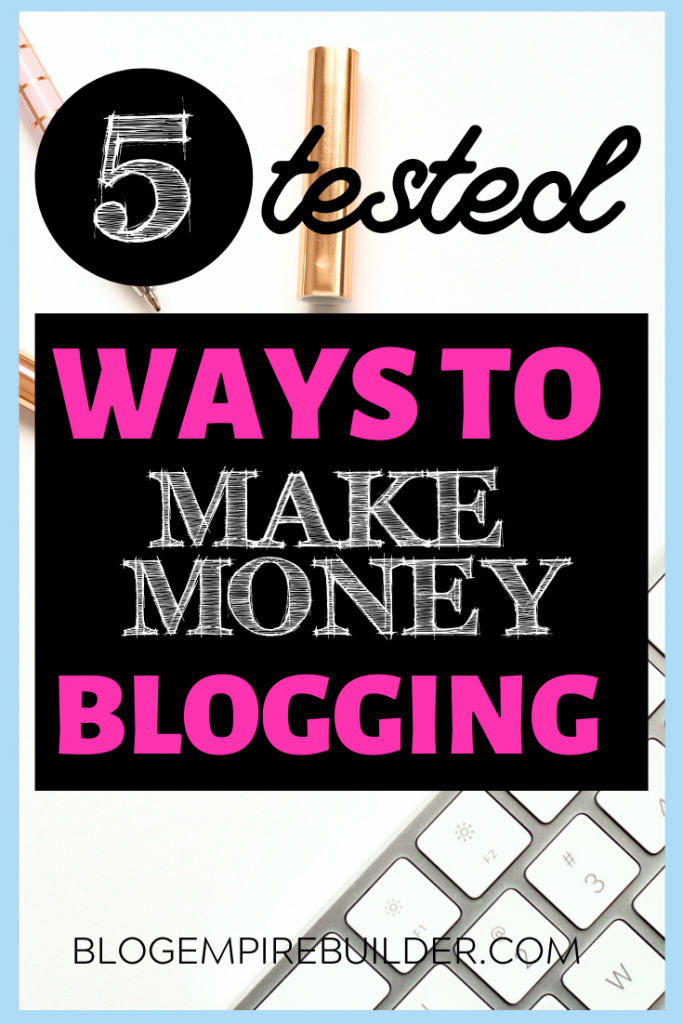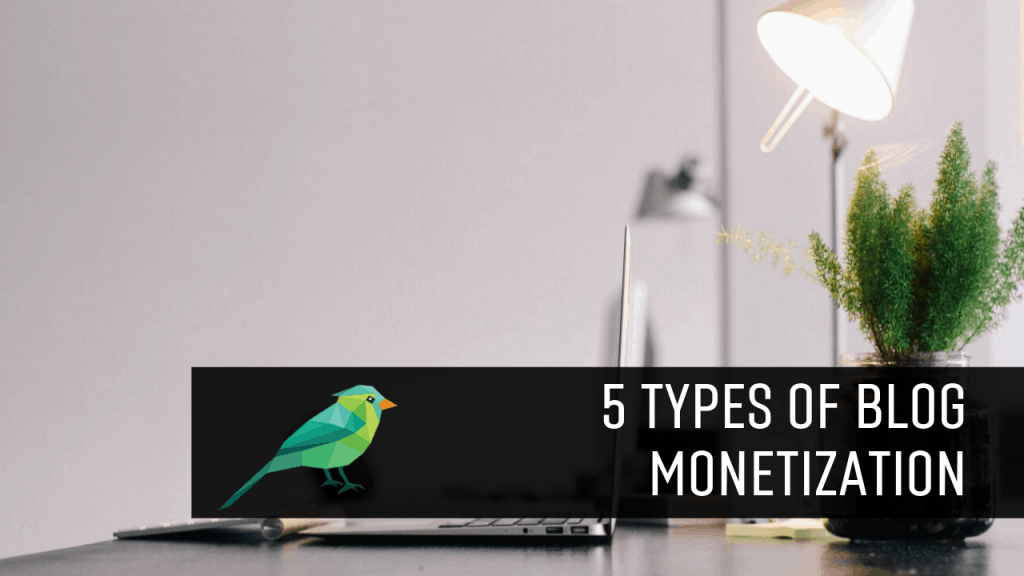We may earn money or products from the companies mentioned in this post.
There are a million different ways to make money with a blog, but they all boil down to 5 basic categories. Before you start any new blog, it's a good idea to think about which methods you'll use and how you'll incorporate them in a way that serves your readers while getting you paid. While you can make money with virtually any blog topic, the optimal monetization mix will be different for everyone.
Table of Contents
Blog Monetization Method #1: Display Advertising

When it comes to blog monetization, this is the big one nearly everybody thinks of. That makes sense. It's a familiar business model, and we see it on everything from newspapers to bus stops to toilet cubicle doors.
When you sell ad space on your site, you generally get paid based on the number of clicks, the number of impressions, or a flat rate for a certain period of time. Flat rate sales are most common when you sell ads directly to advertisers, and ad networks tend to use impression or click-based models. Depending on the ad network you use, ads can be anything from a simple square image to a massive pop-over video.
Pros:
- Ads are nearly always very hands-off, especially if you use an ad network
- If you have a valuable audience or high-traffic site, they can be a nice supplement to other forms of monetization
Cons:
- Not every audience is equally valuable to advertisers
- Many people use ad blockers
- Ads alone won't be enough to make a living with most sites – RPMs (revenue per thousand) tend to range from $1-25, depending on site topic and ad network
- They annoy many users
- Ads can increase your bounce rate and even send your hard-earned readers off to a competitor
Ads can be an important and effective part of your monetization mix, but if you aim to sell your own products or courses, you'll probably want to phase them out as soon as you can. It can cheapen the overall experience and distract people from the things that make you a lot more money.
Display Advertising Companies
Blog Monetization Method #2: Affiliate Marketing

Affiliate marketing is a personal favorite of mine when it comes to blog monetization. I earned my very first commission back in the late 90s, and I've been hooked ever since. I've also started and managed a number of affiliate programs over the years (including a Russian dating program, which made for some interesting stories).
So what IS affiliate marketing? Basically, it's a relationship where one person or company promotes the products or services of a company in exchange for a commission when sales or leads are generated. The most popular example would be Amazon Associates, where thousands of webmasters use specially-formatted affiliate links to send traffic to Amazon and earn commissions on successful sales (and in some cases, bounties on free trials).
Pros:
- While disclosure is a requirement, affiliate marketing is often much more subtle and less aggravating for your readers.
- If you're doing it right, affiliate marketing will pretty much always out-earn display advertising.
- There are suitable programs for most niches.
Cons:
- Depending on your niche, affiliate sales can be very seasonal.
- You won't make much if you don't have engaged traffic that actually converts.
- Takes more effort than simply putting up display ads.
Affiliate marketing can be extremely profitable, and most sites can vastly out-earn their advertising revenue with well-orchestrated affiliate marketing efforts. It should be a part of almost every blogger's monetization mix.
Affiliate Programs and Networks
Blog Monetization Method #3: Services

Offering some kind of service can be a great way to diversify your site income and grow it faster. It can take months or years to work your way up to $2000 months with display ads, but it's quite common to 4 or 5-figure contracts for things like marketing consulting or web development. While I don't personally use a blog to market my consulting services, I know plenty of people who can attribute anywhere from a couple thousand to $10k+/month to clients brought in through their blogs.
Pros:
- Content can be a great way to build trust.
- Depending on the services you offer, offering services can be a pretty straightforward path to a 6-figure income.
Cons:
- Services are hard to scale past a certain point unless you're prepared to hire, train, and manage help.
- Services are not at all hands-off.
- Some people find it tricky to connect with the audience that wants what they're selling (and is willing to pay what they're asking).
- Providing services offers one-time income, and it takes time away from the growth and development of your site and affiliated products.
It's hard to make universally true statements about this particular category because there's an incredible amount of variation. Some people take just a few projects each year and charge enough to earn hundreds of thousands of dollars annually. Others sell $50 website reviews and get excited about an extra few hundreds dollars each month.
The main thing here is to think about whether the services you could realistically sell would (a) bring in the kind of money you want, (b) fit your audience, and (c) give you the kind of lifestyle you desire. If your site gets to the point where you're making $10-20k/month in ads, affiliate income, and products, will you really want to spend your time providing services? Or would you rather put that time into growing your site and offerings further?
Examples of Services
- Online marketing help – PPC, SEO, social media management, etc.
- Graphic design
- Web development
- Coaching
- Public relations/influencer outreach
Blog Monetization Method #4: Sponsored Posts

Sponsored posts have been around for more than a decade, but it's only in recent years that they've gotten really, really popular. As disclosure practices have become standardized and more brands have become comfortable with the idea, the number of sponsored posts on blogs has skyrocketed.
Sponsored posts are a particularly attractive form of monetization for new bloggers because it tends to pay more than they'd earn from most other forms of monetization. There's good reason for that, too. When you provide a sponsored blog post, the brand is paying for three things:
- The time you put into the post
- The immediate views it will get
- The long-term value of the post and any associated links, since most sponsored posts stick around for years
When you do sponsored social media posts, you're paid more on the immediate potential of your current following, since there's less long-term value in a single Instagram, Facebook, or Snapchat post. Sponsored video posts will vary by platform, since some have more long-term exposure and value than others (and in all cases, you should expect to be paid more if you're making the video yourself instead of just re-posting their video).
Pros:
- Sponsored posts can be a great way to make money as your site is growing.
- Sponsored posts often pay very well compared to your actual traffic levels.
Cons:
- It can be a lot of work to find opportunities, create posts, and manage the relationships while also creating your own content and growing your site.
- The desire for more income can easily tempt you into taking opportunities that don't really fit your blog and audience.
- Too many sponsored posts can be extremely off-putting if they're not well-written and well-matched to your audience.
If you look at bloggers from all income levels, you'll notice that sponsored posts play a big role in the <$10k/month realm, but an increasingly smaller one as sites get bigger. That's because they take quite a bit of work, and sites often reach a point where it's more effective to scale up in other ways.
Sponsored Post Companies
Keep in mind – while there are tons of companies that will attempt to match you up with sponsored post opportunities, many of the best opportunities will come from active pitching. That's especially true if you serve a niche audience.
Blog Monetization Method #5: Products

I'm not sure I can say I saved the best for last, but products are definitely one of the best ways to monetize a blog. There are very, very few bloggers earning >$50k/month without the help of a personal product or course.
In most cases, this is not something I'd advise total newbies to jump into right away – especially if you hope to sell something relatively expensive. Ideally, you'd blog for a bit, get to know your audience and their needs,
Pros:
- Products are nearly always scalable (you can sell more and make more money without a lot of additional work for each additional sale)
- A good product can further your branding efforts
- Products are a fairly passive source of income once you get the marketing in place
Cons:
- Products require a lot of up-front investment (either time, money, or both)
- You won't sell much if you don't have an engaged audience that trusts you
- You can waste a lot of time if you guess wrong about what your audience wants and is willing to pay for
Examples of Products
- A premium WordPress theme
- Printable PDF charts, checklists, or planners
- A video course related to your blog topic
- A membership site / pay-to-access content
- A book or e-book
Blog Monetization Bonus Method: Selling Your Site
If you do a good job of growing and monetizing your site, another monetization method will open up to you – you can sell it! While valuing and selling a site could be an entire series of posts, the basics are pretty simple. Create good content, grow your traffic (ESPECIALLY organic search traffic), and diversify your income streams.
A ton of different factors go into valuation, but most sites will sell for somewhere in between 1-3x their annual income. A site with clear growth trends and a valuable brand name will command a higher multiple, while a site in decline will get a lower one. Sites with just one main source of income are likely to earn less than those with multiple proven streams of income. Some buyers will be willing to pay more if they see potential for fast growth, but in general, you're going to get paid for what you've done – not “what could happen if the new owner does — and —“.
While pretty much every form of monetization can be placed in one of the categories above, the individual examples I've given are by no means exhaustive. I'll follow up in the future with more specific posts on each topic. In the meantime, let me know – what methods have you tried, and which ones have worked best for you?


